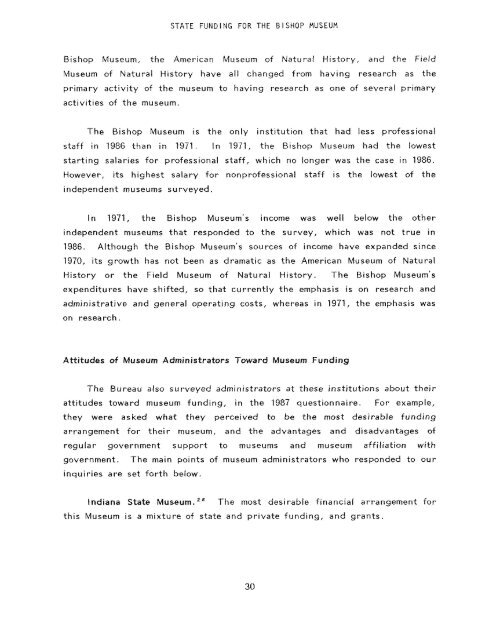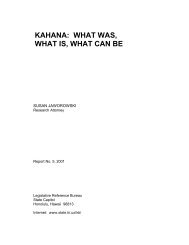State funding for the Bishop Museum - Legislative Reference Bureau
State funding for the Bishop Museum - Legislative Reference Bureau
State funding for the Bishop Museum - Legislative Reference Bureau
Create successful ePaper yourself
Turn your PDF publications into a flip-book with our unique Google optimized e-Paper software.
STATE FUNDING FOR THE BISHOP MUSEUM<br />
<strong>Bishop</strong> <strong>Museum</strong>, <strong>the</strong> American <strong>Museum</strong> of Natural History, and <strong>the</strong> Fieid<br />
<strong>Museum</strong> of Natural History have all changed from having research as <strong>the</strong><br />
primary activity of <strong>the</strong> museum to having research as one of several primary<br />
activities of <strong>the</strong> museum.<br />
The <strong>Bishop</strong> <strong>Museum</strong> is <strong>the</strong> only institution that had less professional<br />
staff in 1986 than in 1971. In 1971, <strong>the</strong> <strong>Bishop</strong> <strong>Museum</strong> had <strong>the</strong> lowest<br />
starting salaries <strong>for</strong> professional staff, which no longer was <strong>the</strong> case in 1986.<br />
However, its highest salary <strong>for</strong> nonprofessional staff is <strong>the</strong> lowest of <strong>the</strong><br />
independent museums surveyed.<br />
In 1971, <strong>the</strong> <strong>Bishop</strong> <strong>Museum</strong>'s income was well below <strong>the</strong> o<strong>the</strong>r<br />
independent museums that responded to <strong>the</strong> survey, which was not true in<br />
1986. Although <strong>the</strong> <strong>Bishop</strong> <strong>Museum</strong>'s sources of income have expanded since<br />
1970, its growth has not been as dramatic as <strong>the</strong> American <strong>Museum</strong> of Natural<br />
History or <strong>the</strong> Field <strong>Museum</strong> of Natural History. The <strong>Bishop</strong> <strong>Museum</strong>'s<br />
expenditures have shifted, so that currently <strong>the</strong> emphasis is on research and<br />
administrative and general operating costs, whereas in 1971, <strong>the</strong> emphasis was<br />
on research.<br />
Attitudes of <strong>Museum</strong> Administrators Toward <strong>Museum</strong> Funding<br />
The <strong>Bureau</strong> also surveyed administrators at <strong>the</strong>se institutions about <strong>the</strong>ir<br />
attitudes toward museum <strong>funding</strong>, in <strong>the</strong> 1987 questionnaire. For example,<br />
<strong>the</strong>y were asked what <strong>the</strong>y perceived to be <strong>the</strong> most desirable <strong>funding</strong><br />
arrangement <strong>for</strong> <strong>the</strong>ir museum, and <strong>the</strong> advantages and disadvantages of<br />
regular government support to museums and museum affiliation with<br />
government. The main points of museum administrators who responded to our<br />
inquiries are set <strong>for</strong>th below.<br />
Indiana <strong>State</strong> Mu~eum.~' The most desirable financial arrangement <strong>for</strong><br />
this <strong>Museum</strong> is a mixture of state and private <strong>funding</strong>, and grants.
















